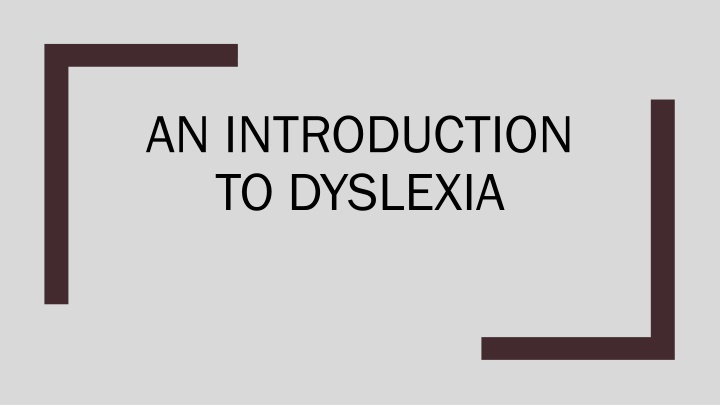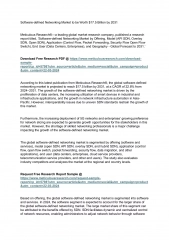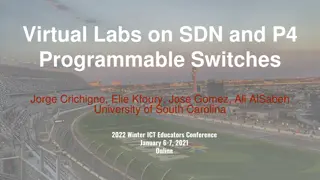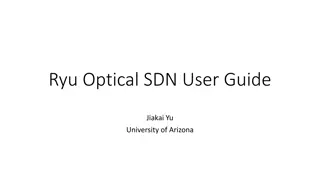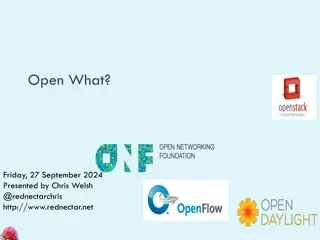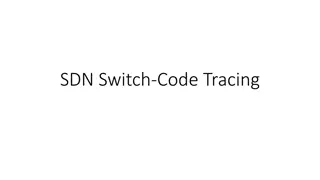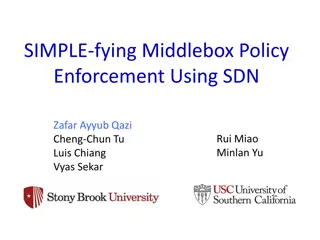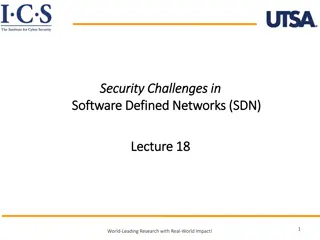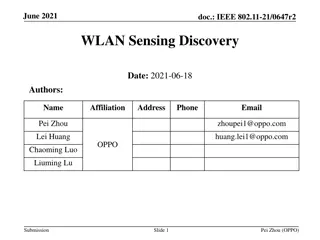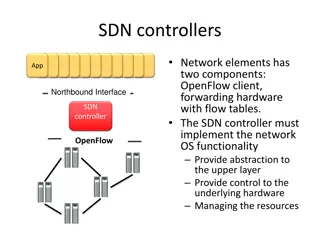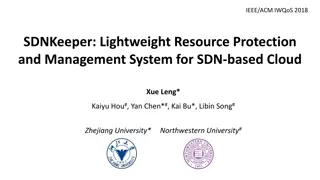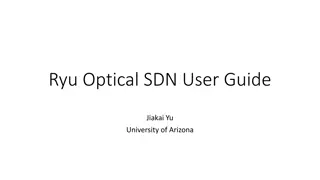Challenges and Opportunities in IXP Evolution towards SDN
Serbian Open eXchange (SOX) has embraced the logical direction of future growth by transitioning towards SDN-ready networks. However, various challenges like lack of best practices, expertise, and tested features hinder the smooth migration to full SDN environments. Despite these obstacles, implementing SDN in IXP environments offers benefits like improved link protection and load balancing. The shift to SDN requires careful consideration of high-capacity switches, migration costs, and the need for continuous service expansion during the transition.
Download Presentation

Please find below an Image/Link to download the presentation.
The content on the website is provided AS IS for your information and personal use only. It may not be sold, licensed, or shared on other websites without obtaining consent from the author.If you encounter any issues during the download, it is possible that the publisher has removed the file from their server.
You are allowed to download the files provided on this website for personal or commercial use, subject to the condition that they are used lawfully. All files are the property of their respective owners.
The content on the website is provided AS IS for your information and personal use only. It may not be sold, licensed, or shared on other websites without obtaining consent from the author.
E N D
Presentation Transcript
AN INTRODUCTION TO DYSLEXIA
WHAT DO I KNOW ABOUT DYSLEXIA?
Myths vs. Reality
Dyslexia is rare. ~ Dyslexia impacts 5% to 17% of the population. Dyslexia is a visual problem. People with dyslexia see things backwards. ~ Dyslexia is a language-based problem, not a visual problem. Everyone who struggles to read is dyslexic. ~ A hyperlexic can read words accurately and fluently, but struggles with comprehension. Reversals are a core feature of dyslexia. ~ Reversals are seen in any individual with low literacy. People who are dyslexic are unable to read. ~ Individuals who receive systematic, explicit instruction can learn to read. Dyslexia is outgrown. ~ They just need more time is one of the most harmful myths. Time to mature doesn t fix the problem.
Dyslexia cannot be diagnosed until 3rd grade. ~ Research indicates dyslexia can be successfully identified as early as the age of 5. Dyslexia is a medical diagnosis. ~ Dyslexia is an educational determination made by assessing reading, spelling, and phonological awareness. There is a test for dyslexia. ~ Dyslexia identification is a process that includes assessments and monitoring how the student responds to instruction. Individuals with dyslexia are just lazy, they need to work harder. ~ Individuals with dyslexia are working harder and often become fatigued quickly due to the way the brain tries to process reading the word. Gifted individuals cannot be dyslexic. ~ Twice exceptional means an individual is both gifted and dyslexic. Colored overlays are an effective treatment for dyslexia. ~ A colored overlay will not fix a phonological or word level reading problem.
Current Reality in Arkansas 32% of 4th grade students in Arkansas are proficient in reading (National Assessment of Educational Progress, 2017) 29% of 8th grade students in Arkansas are proficient in reading (National Assessment of Educational Progress, 2017) 40.6% of 3rd-10th grade students are proficient in Reading (ACT Aspire, 2017) 35% of graduating seniors in Arkansas met reading readiness benchmarks (ACT, 2017) Dyslexia impacts about Dyslexia impacts about 1 1 out of every 5 people. out of every 5 people.
1 in 5 of all people worldwide have dyslexia. 8.5 Million American students have dyslexia. 85% of students with Learning Disabilities have dyslexia. Dyslexia runs in families. Dyslexia runs in families. If a child struggles to read, odds are at least one parent will too. Dyslexia is a neurobiological neurobiological brain difference that affects people s ability to manipulate language manipulate language (not a vision problem). Dyslexia never goes away, but people with dyslexia can learn to read if, and often only if, they are taught with Structured Literacy which helps to rewire their brain. People with dyslexia often suffer low self esteem because they feel stupid, struggle in school and are teased. Dyslexia is in no way tied to IQ. In fact, some of our most successful people have dyslexia
Why does it matter? 85% of youth in juvenile detention facilities have disabilities 85% of youth in juvenile detention facilities have disabilities that make them eligible for special education services, yet only 37% receive these them eligible for special education services, yet only 37% receive these services while in school. services while in school. National Council on Disabilities. June 18, 2015. Breaking the School-to- Prison Pipeline For Students with Disabilities. that make 80% of prison inmates in Texas are functionally illiterate. 80% of prison inmates in Texas are functionally illiterate. 48% have dyslexia dyslexia. . Prevalence of Dyslexia Among Texas Prison Inmates. Moody KC, et al Tex Med 2000. 48% have Students with learning disabilities like dyslexia have a Students with learning disabilities like dyslexia have a three times higher risk of attempting suicide risk of attempting suicide. . Suicidality, School Dropout and Reading Problems Among Adolescents. Journal of Learning Disabilities, vol. 39,6: pp 507-514. First published Nov. 1 2006. three times higher 89% of suicide notes 89% of suicide notes have dyslexic Adolescent Suicide. Journal of Learning Disabilities, Vol. 30, 6: pp 652-659. Published first Nov. 1, 1997. have dyslexic- -type spellings in them. type spellings in them. Learning Disabilities and
Meeting the Needs of Children with Dyslexia in Arkansas Public Schools Act 1294 of 2013 Act 1268 of 2015 Act 1039 of 2017 A.C.A. 6-41-601, Title 6, Subtitle 3, et al.
Components of the Law A.C.A. 6-41-601 Findings A.C.A. 6-41-602 Definitions A.C.A. 6-41-603 Required screening and intervention A.C.A. 6-41-604 Level II Dyslexia Screening and Services A.C.A. 6-41-605 Instructional approaches A.C.A. 6-41-606 Reporting by school districts A.C.A. 6-41-607 Dyslexia Specialist A.C.A. 6-41-608 Dyslexia Professional Awareness A.C.A. 6-41-609 Dyslexia and related disorder education in teacher education programs A.C.A. 6-41-610 Rules - Dyslexia Resource Guide A.C.A. 6-41-611 Enforcement - Rules
Components of the Law Act 1268 of 2015 Act 1268 of 2015 Required screening and RTI Parent notification and resources Instructional approaches 1268 how it relates to 504/IDEA Dyslexia professional awareness for all teachers Act 1039 of 2017 Act 1039 of 2017 (a) The superintendent of a school district annually shall report the results of the school district screening required under 6-41-603. (b) Before July 15, a public school district shall report on the website of the public school (1) The dyslexia intervention programs used during the previous school year (1) The dyslexia intervention programs used during the previous school year (2) The number of students who received dyslexia intervention (2) The number of students who received dyslexia intervention (3) The total number of students identified with dyslexia (3) The total number of students identified with dyslexia
Research Based Definition Dyslexia is a specific learning disability that is neurological in origin. It is characterized by difficulties with accurate and/or fluent word recognition and by poor spelling and decoding abilities. These difficulties typically result from a deficit in the phonological component of language that is often unexpected in relation to other cognitive abilities and the provision of effective classroom instruction. Secondary consequences may include problems in reading comprehension and reduced reading experience that can impede the growth of vocabulary and background knowledge. Adopted by the Board of Directors, International Dyslexia Association: November 2002
Lesson by Kelli Sandman-Hurley, animation by Marc Christoforidis.
Dyslexia means a specific learning disability that is: Neurological in origin Characterized by difficulties with accurate and fluent word recognition and poor spelling and decoding abilities That typically results from a deficit in the phonological component of language And are often unexpected in relation to other cognitive abilities
Dyslexia means a specific learning disability that is: Neurological in origin Characterized by difficulties with accurate and fluent word recognition and poor spelling and decoding abilities That typically results from a deficit in the phonological component of language And are often unexpected in relation to other cognitive abilities
Word Word Word Identification Word Identification Recognition Recognition Decoding Decoding Clard Phim Stenk Bufty Tadding Wubfambiffy gnouthe
Analyzing Spelling Errors Phonological Errors: Omissions Sound Confusions Sound Order Orthographic Errors: Phonemes are represented by incorrect grapheme.
Profiles of Reading Difficulty Good Language Comprehension Dyslexic Skilled Reader Poor Language Comprehension Mixed Difficulties Hyperlexic Poor Word Reading Good Word Reading
Dyslexia means a specific learning disability that is: Neurological in origin Characterized by difficulties with accurate and fluent word recognition and poor spelling and decoding abilities That typically results from a deficit in the phonological component of language And are often unexpected in relation to other cognitive abilities
Phonological Awareness Phonological awareness is the awareness of the sound structure of language deals with the larger chunks of language like words, syllables, and onsets/rimes. Say baseball without the -ball How many syllables are in tricycle
Phonemic Awareness The number one predictor of reading success! Metacognitive appreciation of the explicit sounds (phonemes) in spoken words Demonstrated by listening and - Blending spoken sounds - Segmenting spoken words into sounds - Manipulating spoken sounds Say guide. Now say guide, but change the /g/ to a /r/ ride
An explanation of the Phonological Awareness Continuum. PAST J-M PAST H-I #1 predictor of reading success. Students must have this to successfully apply phonics instruction. PAST F-G PAST D-E
Dyslexia means a specific learning disability that is: Neurological in origin Characterized by difficulties with accurate and fluent word recognition and poor spelling and decoding abilities That typically results from a deficit in the phonological component of language And are often unexpected in relation to other cognitive abilities
Thinking, reasoning, and understanding are untouched by dyslexia. Overcoming Dyslexia by Sally Shaywitz, M.D.
If we dont have an IQ test, how can we tell? If we don t have an IQ test, how can we tell? Other Cognitive Abilities Listening Comprehension Expressive Language Vocabulary Math Calculation Math Reasoning...
What does effective instruction look like?
A MULTI-TIERED SYSTEM OF SUPPORT Teach all students (Tier 1) Reading, Structured Literacy curriculum, which prepares students to decode words in an explicit and systematic manner. (Tier 1) with a Science of Provide targeted Tier 2 explicitly reteach critical concepts in small groups so students develop automaticity. These students get a double dose. students get a double dose. Tier 2 interventions that These When students are not making growth with Tier 1 and Tier 2 instruction, we need to add Tier 3 dyslexia intervention dyslexia intervention instruction to provide intense, small group, targeted intervention. These students get a triple dose These students get a triple dose Tier 3 Tier 3 Tier 3 Tier 2 Tier 2 Tier 2 Tier 2 Tier 1 Tier 1 Tier 1 Tier 1 Tier 1 Tier 1
Interventions must be systematic, cumulative, sequential, multisensory and evidence based. (i.e. Science of Reading) Duration will be based on the intervention program chosen and needs of the student
Why is this specific instruction important? Elizabeth Huber, Patrick M. Donnelly, Ariel Rokem, Jason D. Yeatman. Rapid and widespread white matter plasticity during an intensive reading widespread white matter plasticity during an intensive reading intervention intervention. Nature Communications, 2018; 9 (1) DOI: 10.1038/s41467-018- 04627-5 Rapid and
What does it feel like to have a learning disability Fairness Risk Taking Risk Taking Decoding Decoding Fairness Fairness Processing Processing Perception and motivation Perception and motivation anxiety anxiety Perception and motivation Dysgraphia, note taking Dysgraphia, note taking comprehension comprehension Experiencing LD Experiencing LD extended time Dysgraphia, note taking extended time
What does Dyslexia look like in the classroom?
Dyslexia in Secondary students: Struggle with oral language Struggle to find the right word Unable to create a summary Listening vocabulary is higher than spoken vocabulary Often struggle with organization
Adolescents: Hide reading problems Rely on memory Avoid reading, let others read for them May not be able to write, dysgraphia International Dyslexia website- interdys.org
Accommodations and/or Modifications Students may need a ramp to access grade level material while we build up reading skills. The following accommodations may be appropriate. Students must have a 504 plan or an IEP to possible receive these accommodations/modification for state and national testing. Decisions about individual students should be made by the SBIT/504/IEP team. Writing Writing Reading Reading Allow audio books and/or text-to-speech software Utilize outlines, summaries Preview questions and vocabulary Allow peer reading support (discreet and supportive) Grade for content rather than spelling Allow students to dictate work to an adult Substitute alternative projects for written reports Utilize speech-to-text software Reduce written work Minimize copying Accept oral responses, reports, and presentations
Accommodations and/or Modifications continued.. Accommodations and/or Modifications continued.. Instruction Instruction Break task and directions into small steps Emphasize daily review Provide copy of notes Classroom Classroom Post schedules and maintain routines Chart assignments on a calendar Use color coding to organize materials and information Incorporate multisensory activities Coordinate preferential seating Avoid requiring student to read aloud in front of a group. Testing Testing Provide extra time Review directions orally Read test orally Allow dictated response Homework Homework reduce reading and writing requirements Limit time spent on homework Provide extra time
What do I do if I suspect a child has dyslexia? Teacher Referral Form Parent Interview Screening Packet Flow Charts
Support Google Drive: Website: lrsd.org/dyslexia (includes assistive technology support) Your literacy facilitator Your reading teacher Your special education staff Me: Chandle Carpenter, 501-447-1060, chandle.carpenter@lrsd.org
